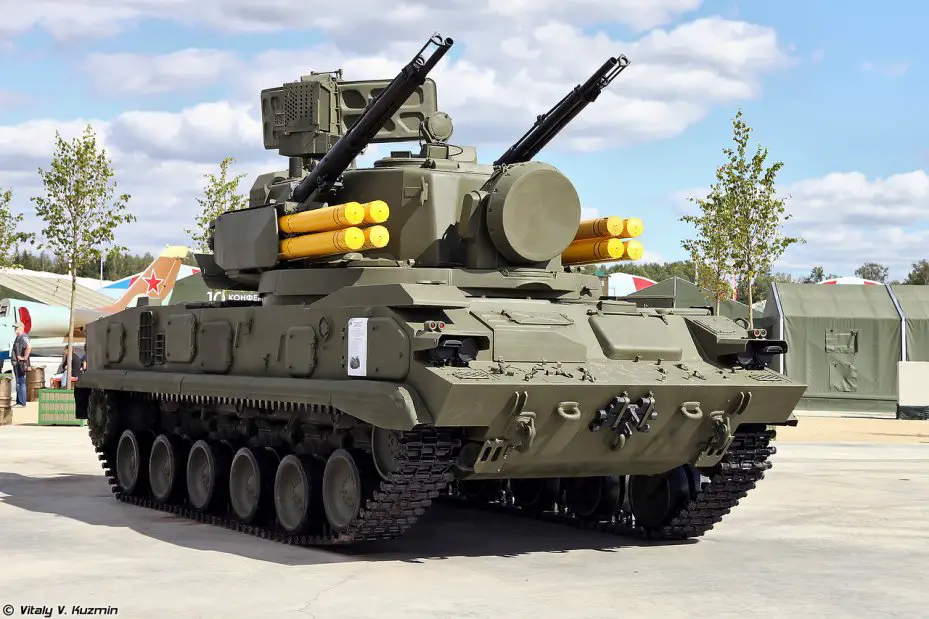- Army
- Conflicts in the world
- Israel - Iran conflict 2025
- Pakistan - India Conflict 2025
- Russia Ukraine War 2022
- Libya conflict day by day
- HAMAS - Israel War 2023
- Operation Serval in Mali French Army
- Sangaris operation Central African Republic
- Sangaris opération militaire République Centreafrique
- Ukraine - Russia conflict
- Syria conflict news
- Defence & Security Industry Technology
- Armies in the world
- Analysis Defense and Security Industry
- Conflicts in the world
- Navy
- Air
Ukrainian Army Uses Soviet-made 2S6 Tunguska Air Defense Vehicle to Intercept Missiles and Drones
The Ukrainian armed forces have successfully shot down cruise missiles and drones using their 2S6 "Tunguska" self-propelled missiles/cannons air defense vehicles. This achievement was confirmed by a photograph published by the analyst OSINTtechnical on June 4, 2023, which shows the Ukrainian air defense system intercepting the missile.
Follow Army Recognition on Google News at this link

Ukrainian 2S6 Tunguska with two distinct marks representing the downed targets. (Picture source Twitter Osinttechnical )
The photograph reveals two distinct marks on the Ukrainian 2S6 "Tunguska" air defense vehicle, representing the downed targets. Among them are a cruise missile and an Iranian Shahed drone. This success highlights the effectiveness of the Ukrainian forces in protecting their territory.
Furthermore, the 2S6 "Tunguska" air defense vehicle is adorned with symbols of the 24th Independent Mechanized Brigade, named after King Danylo.
It is noteworthy that since October, the 2S6 "Tunguska" air defense vehicle has been deployed in the Donetsk region to ensure the security of mechanized forces against aerial threats. The capabilities of these anti-aircraft systems have been utilized to counter enemy attacks and protect ground troops. At the beginning of the conflict, the Ukrainian army had 75 Tunguska 2S6 air defense vehicles according to Military Balance 2022.
The 2S6 "Tunguska" system is a combination of anti-aircraft missiles and artillery, designed to engage various aerial targets, including drones. Although this technology is of Soviet origin and considered obsolete, the Ukrainian military has succeeded in shooting down a cruise missile through strategic use.
The armament of the 2S6 Tunguska-M1 includes eight surface-to-air missiles 9M311-M1, known as "Grison" by NATO. These missiles are equipped with a semi-automatic visual guidance radar and are capable of engaging targets moving at speeds of up to 500 m/s. Weighing 40 kg with a 9 kg warhead, these missiles measure 2.5 meters in length, 1.7 meters in diameter, and have a wingspan of 2.2 meters. Their range extends from 15 to 6,000 meters against ground targets and from 15 to 10,000 meters against aerial targets.
In addition, the Tunguska-M1 is equipped with twin 30 mm anti-aircraft cannons, capable of firing up to 5,000 rounds per minute. These cannons are formidable against aerial targets at a range of up to 3,000 meters and ground targets up to 4,000 meters. The vehicle is also equipped with a complete set of detection and tracking systems, including an acquisition radar with an 18 km range and a tracking radar with a 16 km range. The armored turret of the Tunguska-M1 is mounted on a robust 34-ton chassis, similar to that of the ZSU-23-4, and is powered by a multi-fuel engine.
With its offensive capabilities, the Tunguska-M1 provides comfort and functionality to operators with its air conditioning, heating, and air filtration system. Its hydropneumatic suspension system adapts to traversed terrains, ensuring optimal mobility. A typical Tunguska-M1 battery can consist of six vehicles, accompanied by replenishment vehicles to ensure maintenance and reloading of the systems.
The Ukrainian armed forces are aware of the importance of protecting these air defense systems against enemy threats. Therefore, they avoid exposing them to the views of enemy infantry and technology while maintaining their operational effectiveness.
Despite the 2S6 "Tunguska" being of Soviet origin and considered outdated by some standards, its strategic deployment and efficient use have demonstrated its continued relevance and effectiveness on the modern battlefield. The combination of surface-to-air missiles and twin anti-aircraft cannons provides a versatile and potent defense against aerial threats, including drones and cruise missiles.



























